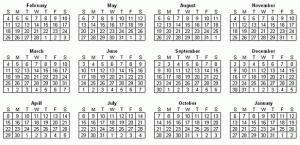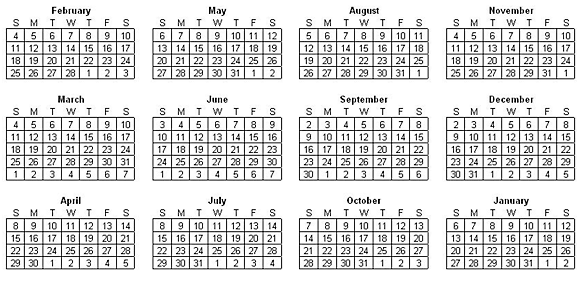The 4-5-4 Calendar is ideal for merchandise analysis and planning as it divides the year into comparable periods of time. Rather than incrementing periods based on the Gregorian calendar, the 4-5-4 Calendar divides the year into four and five week periods. Unlike the Gregorian calendar, the 4-5-4 calendar assures that comparable periods always include not only the same number of selling days, but the same number of each day of the week. For example, there are always 4 Saturdays in a 4 week month (and 5 Saturday’s in 5 week periods). The result is that when preparing sales and the resulting inventory plans, the analyst doesn’t need to calculate and accommodate as many variances when planning or worse yet be surprised when prior year comparisons are influenced by the number of selling days instead of true changes to selling trends.
The 4-5-4 Calendar divides the year into 4 and 5 week periods (months). The first period has 4 weeks, the next 5 weeks, then 4 weeks and the process is repeated so that the fourth month starts over with 4 weeks. While the 4-5-4 calendar provides much more consistency than the Gregorian calendar year, a planner must still concern themselves with some Holidays (such as Easter) or events (such as promotional or community events) that do fall in different months from year to year. Even weather patterns can greatly affect sales in otherwise comparable periods from one year to the next.
While a company’s corporate structure may not always allow for the use of a 4-5-4 calendar for fiscal purposes, it is otherwise a valid fiscal calendar. But even if a company’s fiscal calendar is different, the 4-5-4 calendar can still be used for merchandising and Open to Buy planning. For example, an IRS requirement for S-Corporations is that the fiscal year must coincide with the calendar year as profits are reported as income for each shareholder. The Merchant Plus! system accommodates the ability to have a different Fiscal Year (defined in GL Period Maintenance) as well as a different Inventory Calendar (using Inventory Period Maintenance). While this provides the important balance for merchandise planning, it also involves a conflict between Financial Budgets and Merchandising Plans. Since good merchandise planning is critical to success in retailing, this inconvenience is worth the trouble.
When corporate structure allows for it, most retailers opt for a fiscal year that ends at the end of January (or often July) so the retailer doesn’t need to close their financial period directly on the heels of the peak selling season. This is especially important when the tax benefits of the Retail Inventory Method are being used as is provides time for a retailer to take season end clearance markdowns (and lower inventory valuation, profits, and taxes) on a more practical time frame than the calendar year end. Even if markdowns break immediately after Christmas, six days can be a tight window of opportunity to markdown merchandise when most of us are just catching our breaths. Moreover, as Gift Card sales increase full price selling opportunities until the day after Christmas, clearance sales continue to be pushed back. It might even be reasonable to have a fiscal year end in February as the 4-5-4 calendar can be applied based on having a fiscal year end in any month.
Every Seven Years a Week is Added
If a 4-5-4 Calendar is used for fiscal reporting an IRS regulation requires that an extra week be added to the calendar every seven years to assure that the fiscal year end always falls on a Saturday closest to the last day of the month. Even if the 4-5-4 calendar is used only for merchandising purposes, the extra week should be periodically added to assure that periods don’t substantially shift over time.
The condition on which the 5th week is added to January is as follows (according to IRS regs): The year ends on the last Saturday of the year-end month, unless the first Saturday of the following month is closer to the last calendar day of the month. Therefore, if Jan. 31 is on a Tuesday, then January ends on the prior Saturday. However, if Jan. 31 is a Wednesday, the following Sat. is closer (3 days) so the fifth week is added.
“A 52-53 week tax year must end on the date a specified day of the week last occurs in a particular month or on the date that day of the week occurs nearest to the last day of a particular calendar month. The year-end is described as follows: last Saturday in January or Saturday nearest to January 31.”
All 4-5-4 calendars are not created equally!
While “standard” 4-5-4 calendars are published (usually with a year end at the end of January), each company must define their own calendar. Calendars not only vary based on the month required for the year end, but also for when the calendar was started for each company. Moreover, if a fifth week was inadvertently skipped in one fiscal year, the newly calculated year end dates won’t catch up to the calendar that should have been followed. Therefore, it is important that each company properly defines their own 4-5-4 calendar as there is no universal calendar that can or should be used.



Read more straight from the horse’s mouth.
IRS Publication 538
I am curious about the IRS requirement for adding an extra week for seven years? IRS Publication 538 is rather dearth on this subject. Even conversations with the IRS, leave me scratching my head.
Can the retailer add the extra week on their whim? Is there a steadfast rule for that?
In this statement: last Saturday in January or Saturday nearest to January 31 is the ‘or’ portion optional? or a must?
Does this apply to only 4-5-4? or other implementations, e.g. 5-4-4 or 4-4-5
As you would suspect, the IRS language is a bit confusing but it does confirm the explanation in this article. No, the retailer can’t guess at the last day of the year. If the month always ends on a Saturday, they the year end is on the Saturday “nearest to the last day of the calendar month”. It must be the Saturday closet to the end of the month whether it is in January of February. It applies to any 52-53 week year as the difference between a 4-5-4, 5-4-4 and 4-4-5 calendar is the month started in. Traditionally, retail 4-5-4 calendars end in January because it tends to be a slower month and has a lesser impact on planning when comparing a 4 week to a five week period every seven years.
Thanks for the comment – good questions.